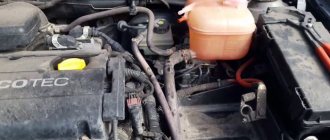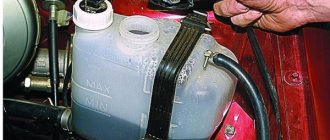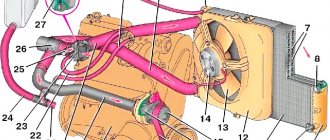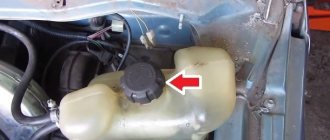Expansion tank in a car cooling system
Even a short trip by car will be impossible if the car's cooling circuits are faulty. Modern vehicles are driven by thrust generated by combustion processes. The gas-fuel mixture, entering the engine combustion chamber, disintegrates, imparting part of the released energy to the engine's CPG. Normal operation of the system is impossible if all the conditions required for uniform and stable combustion of fuel are not met.
The automotive cooling system maintains the temperature required for engine operation. Most modern vehicles are characterized by the presence of 2 types of internal combustion engine cooling - air and liquid. The engine is cooled with air thanks to the operation of fans, and the operation of liquid cooling is supported by the circulation of the cooler in the radiator circuit. The coolant enters the internal combustion engine and picks up some of the heat during the heating process, and then exits into the expansion tank, from where it is sent to the radiators for cooling.
Damage to the expansion tank
A car's expansion tank is usually made of off-white or black plastic. Its shape and dimensions can vary markedly depending on the make and model of the vehicle in which it is installed. There are designs of expansion tanks made of aluminum alloy, intended for tuning the engine compartment. Standard tanks have two coolant outlets and a coolant refill hole with a cap.
The technical characteristics of the cooling circuit capacity determine typical problems that may arise during the operation of automotive expansion tanks:
- Broken cooling circuit hoses.
- The inlet cover is broken.
- Destruction of the plastic case.
All three risk factors are associated with the physical impact of the coolant on the expansion tank chamber.
An aqueous solution of alcohol containing a complex of additional additives is used as a coolant. Additives ensure the most efficient heat transfer and minimize the destructive effect of the coolant on the engine. Russian retail chains of automotive chemicals will offer customers 2 types of coolant - antifreeze and antifreeze.
Antifreeze is a domestic development, differing in the types of additives and price. Antifreeze costs several times more and can provide more effective protection of the internal combustion engine from wear.
The coolant entering the expansion tank often has a fairly high temperature, and in some cases it can boil right in the plastic container. Boiling of the coolant in the expansion tank often leads to its deformation. It also happens that under the influence of heated antifreeze, the tank bursts, the cooler hoses break, or the lid of the tank is knocked out. To prevent such situations, special valve cover designs have been developed.
List of tools used when replacing containers
To remove the old tank and install a new one efficiently, you need to acquire the following standard tools:
- wrenches (set);
- pliers;
- Screwdriver Set;
- new clamps (the use of old clamps is undesirable);
- sandpaper.
Sandpaper is used to process the inlet holes in the new plastic tank in order to eliminate existing roughness. Smooth surfaces of the holes will ensure tightness, strength and reliability when screwing the plug.
Valve cover and expansion tank sensors
Valve covers of expansion tanks are a composite mechanism of several plates, springs, locking and connecting parts. Valve cover design may vary depending on the make and model of the vehicle. Despite all the model differences, the design of any valve is extremely simple, and even a child can figure it out.
The valve cover performs the function of relieving excess pressure to protect the expansion tank body from deformation and rupture. When the pressure created by the boiling coolant inside the expansion tank reaches a critical level, then the valve on the cap opens and the excess coolant volume is released into the engine compartment. If the vehicle engine often “boils,” it is worth checking the coolant level in the system.
The fact that repair of the expansion tank cap is necessary may be indicated by frequent “boiling” of the car or the appearance of coolant stains where the vehicle is parked. The reasons for the malfunction of the cover can be very different - from metal fatigue in the design of the valve mechanism to soldering of valve parts to each other. To check its operation you will need a pressure gauge and a car pump. They must be connected to the expansion tank instead of hoses. A working cap will not allow the pressure in the tank to rise above the permissible limit.
Frequent bleeding of excess pressure in the expansion tank leads to a shortage of process fluid in the cooling system. The result of a lack of coolant in the system is regular “boiling” of the internal combustion engine and the inability to fully use the vehicle. The lack of antifreeze in the expansion tank should be indicated by the on-board computer or lights on the car’s dashboard. They read data from the float sensor in the expansion tank chamber.
What does he look like?
Externally, the expansion tank is a plastic container. Liquid is poured inside this container, which is directly involved in cooling the engine.
The design of the element includes hoses closed in a circuit, a float sensor built into the lid or plug of the tank. Whichever is more convenient for you. It is this sensor that transmits information about the current coolant temperature. When the permissible values increase, the corresponding warning light lights up on the dashboard.
Complete structure
Where is he located?
To replace a damaged container, you first need to determine where it is located.
The location of the expansion tank is the engine compartment on the driver's side, right behind the pillar glass.
Such an arrangement in the VAZ 2110 certainly cannot be called successful, since there are metal elements on all sides of the plastic tank. Because of this, problems arise with the expansion of the plastic, sometimes the tank simply bursts.
Depressurization of the tank occurs especially often in the summer, when there is intense heat outside. The manufacturer, represented by AvtoVAZ, took this problem into account when developing new models. And the owners of the “ten” have to put up with this arrangement of the tank.
Container location
Repair, replacement and modernization of the expansion tank
The coolant level sensor is part of the design of most expansion tanks. This is the only part of the expansion tank housing that can be repaired. In fact, all repairs to the expansion tank come down to repairing the coolant level sensor or replacing it. Any motorist who has repaired something on their car at least once in their life can change it.
Modernizing the expansion tank involves installing a modern valve cover if the design of the current one cannot perform the function of relieving pressure. If the cap was replaced due to antifreeze leaks, and after installing a new or repaired cap, the leaks did not stop, then the tank will have to be replaced. The procedure is simple and universal - replacing the expansion tank of a VAZ is not much different from replacing the tank on a foreign car.
In order to change the tank, just follow 4 steps:
- Disconnect the cooling system hoses.
- Unscrew the mounting screws, if any.
- Remove the old reservoir from the engine compartment.
- Install the new expansion tank in place of the old one, securing it with screws and connecting the hoses.
The cost of the tank is low, but can vary significantly depending on the store. It often turns out that purchasing auto parts at an auto repair shop is much cheaper than buying it at a shopping center. It would be advisable to turn to the help of a vehicle service and repair center if you don’t have the time to independently search for a tank in nearby stores, and you don’t have the desire to install it. The car service aggregator Uremont.com will help you find the nearest car service center that has the necessary parts in stock.
Recommendations for selection
For VAZ 2110-12 models, you can find 2 types of expansion tanks on sale:
- old model with two necks: the coolant level sensor is screwed into the first, and the second is closed with a plug with a release valve;
On old-style products, a second neck was made for installing an antifreeze level sensor
- a new model with one neck (without sensor) and a body convex on the sides.
The new sample container does not have a level sensor
If your car has a sensor in an expansion tank, then you need to select an old-style product. Accordingly, versions without a sensor will require a new reservoir design.
For VAZ 2114-15 models, tanks of the same shape are offered with 3 fittings: two of them are located at one end, and the third is located at the opposite end. Products for the VAZ 2110 and 2114 are not interchangeable with each other, although if you really want to, attaching a part from another model is quite possible. Another thing is that there is no need for this - both varieties are available for free sale and practically do not differ in price.
The reservoir for models 2114-15 has a wider shape and a versatile arrangement of fittings
When purchasing an expansion tank for any series of cars of the “tenth” family, pay attention to the following points:
- the plastic of a quality product should be light and half transparent;
- cracks in the corners or near the fittings are unacceptable;
- the plastic should not be “oaky” or have dark impurities visible to the naked eye;
- look on the body for an imprint of the manufacturer's trademark and catalog number (21083–1311014 for VAZ 2114).
For all modifications “ten”, “fourteen” and “fifteen” a small tuning is available - installation of an expansion tank from the cooling system of a Lada Priora car. Why and how this is implemented will be discussed below.
The reservoir of the Priora cooling system has a rectangular shape and 3 fittings on the front wall











